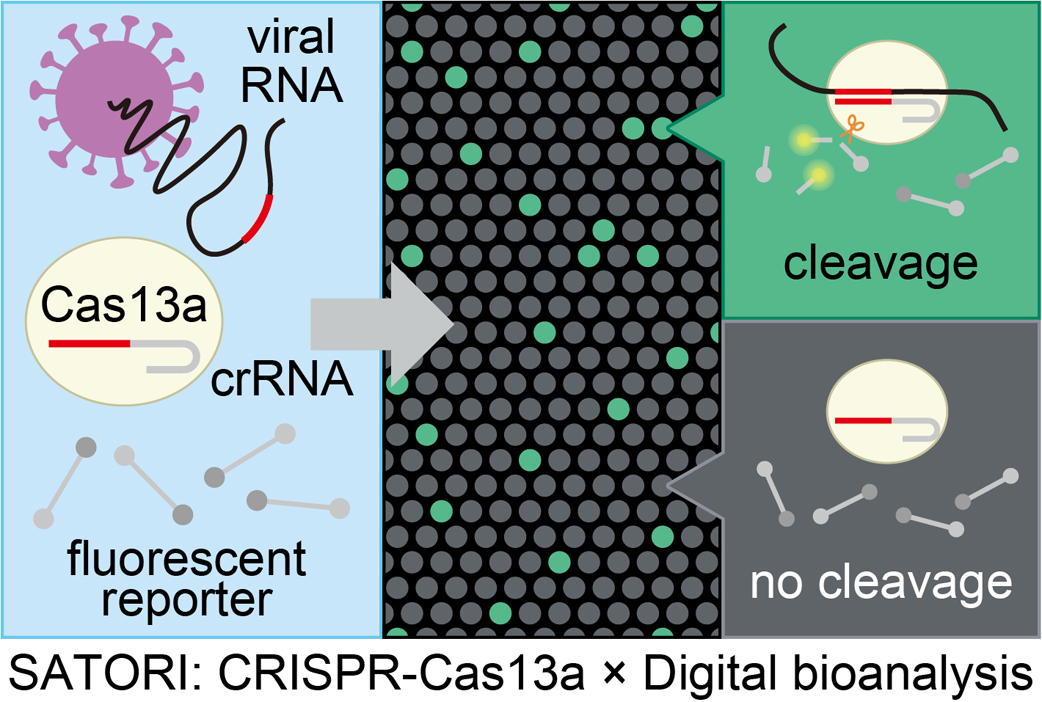1 0 0 0 OA SATORI: Amplification-free digital RNA detection method for the diagnosis of viral infections
- 著者
- Tatsuya Iida Hajime Shinoda Rikiya Watanabe
- 出版者
- The Biophysical Society of Japan
- 雑誌
- Biophysics and Physicobiology (ISSN:21894779)
- 巻号頁・発行日
- vol.20, no.3, pp.e200031, 2023 (Released:2023-07-22)
- 参考文献数
- 21
- 被引用文献数
- 2
With the recent global outbreak of COVID-19, there is an urgent need to establish a versatile diagnostic method for viral infections. Gene amplification test or antigen test are widely used to diagnose viral infections; however, these methods generally have technical drawbacks either in terms of sensitivity, accuracy, or throughput. To address this issue, we recently developed an amplification-free digital RNA detection method (SATORI), which can identify and detect viral genes at the single-molecule level in approximately 9 min, satisfying almost all detection performance requirements for the diagnosis of viral infections. In addition, we also developed practical platforms for SATORI, such as an automated platform (opn-SATORI) and a low-cost compact fluorescence imaging system (COWFISH), with the aim of application in clinical settings. Our latest technologies can be inherently applied to diagnose a variety of RNA viral infections, such as COVID-19 and Influenza A/B, and therefore, we expect that SATORI will be established as a versatile platform for point-of-care testing of a wide range of infectious diseases, thus contributing to the prevention of future epidemics. This article is an extended version of the Japanese article published in the SEIBUTSU BUTSURI Vol. 63, p. 115–118 (2023).
1 0 0 0 OA SATORI: Amplification-free digital RNA detection method for the diagnosis of viral infections
- 著者
- Tatsuya Iida Hajime Shinoda Rikiya Watanabe
- 出版者
- The Biophysical Society of Japan
- 雑誌
- Biophysics and Physicobiology (ISSN:21894779)
- 巻号頁・発行日
- pp.e200031, (Released:2023-07-12)
- 被引用文献数
- 2
With the recent global outbreak of COVID-19, there is an urgent need to establish a versatile diagnostic method for viral infections. Gene amplification test or antigen test are widely used to diagnose viral infections; however, these methods generally have technical drawbacks either in terms of sensitivity, accuracy, or throughput. To address this issue, we recently developed an amplification-free digital RNA detection method (SATORI), which can identify and detect viral genes at the single-molecule level in approximately 9 min, satisfying almost all detection performance requirements for the diagnosis of viral infections. In addition, we also developed practical platforms for SATORI, such as an automated platform (opn-SATORI) and a low-cost compact fluorescence imaging system (COWFISH), with the aim of application in clinical settings. Our latest technologies can be inherently applied to diagnose a variety of RNA viral infections, such as COVID-19 and Influenza A/B, and therefore, we expect that SATORI will be established as a versatile platform for point-of-care testing of a wide range of infectious diseases, thus contributing to the prevention of future epidemics. This article is an extended version of the Japanese article published in the SEIBUTSU BUTSURI Vol. 63, p. 115-118 (2023).

